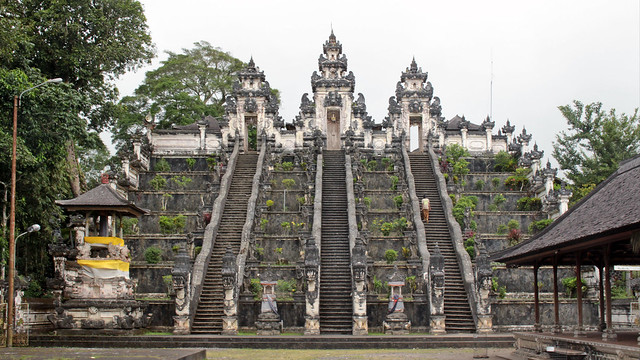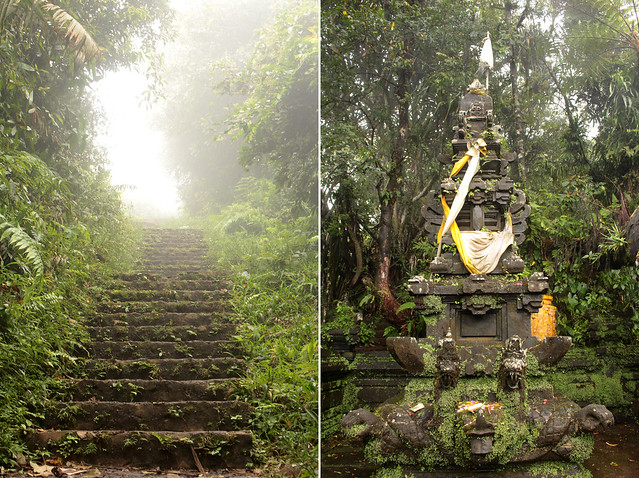Oct 10, 2013
Pura Lempuyang
Balinese culture is steeped in spirituality, and therefore it is not a surprise that there are tens of thousand Hindu temples all over the island. Bali is, afterall, “the Island of a Thousand Puras”. Some of the temples are small and territorial, located within private compounds (usually among the wealthier clans) or local community-based (each village has at least 3, known as kahyangan tiga), while the larger public temple complexes are revelled by Balinese near and afar, and they are also among the most visited by non-Balinese.




There are other additional layers of reverence of public temples: nine temples that come together to form the kahyangan jagat (directional temples) which protect the island from evil spirits, six temples that form the sad kahyangan (temples of the heavens or temples of the world), two temples of dang kahyangan that honours the introduction and teaching of Hinduism in Bali – it really is quite fascinating to get to know the intricate network of religious purposes.
Pura Lempuyang in Karangasem is both a directional temple and a temple of the heaven. Located on the slopes of the mountain bearing the same name, this is not a public temple for the faint-hearted. Often enshrouded by misty clouds (hence its location in the heaven, I guess) there are seven levels of temples altogether, linked by over 1,700 steps within jungle path. Assuming 20 steps per flight of stairs, that’s over 85 storeys to walk up! This translates to about 1.5-2 hours uphill trek, depending on one’s fitness, bearing in mind the heat (even if temperature falls as you go higher) and the humidity too. During the rainy season, the slopes and the stones may also be treacherously slippery.




By the car park, a small hut is poised at the entry point to the complex. Here, a donation is solicited in lieu of entry fee, and for anyone without sarong of their own, it can be rented here too. F and I also debated about getting a guide, since we were not completely familiar with customs of this pura and didn’t want to commit particular faux pas, not to mention we’d like to get to know the features of the temple a bit more.
Clearly we were not very good at bargaining or we just had big suckers flashing on our foreheads. We somehow ended with a “deal” where the guide, Wayan Bon Jovi (“like the American rockstar”) would briefly tell us the history and the set up of the temples. However, due to recent illness (some kind of heart problem) he was unable to trek all the way up for now and his daughter would show us the way instead. Mind, she doesn’t speak English, so we would not be able to get much additional info from her.




At the first Pura Penataran Agung Lempuyang, Wayan informed us that this is the oldest temple in Bali, given its status as a sacred site even in pre-Hindu times. It is special in that it is one of the very few holy sites with its own source of holy water. The holy water “grows” inside the bamboo found at the temple complex – sorry, details a bit sketchy since he was speaking rather animatedly and not in particularly clear English, so I grasped the gist instead – following a series of prayers by the priest on behalf of intended devotees. Anyone who comes to pray with impure mind and spirit, among many other cultural prohibitions, would not find themselves blessed with a collection of the holy water.
It was also here that we learned about the basic architecture of a Balinese temple. The temple orientation is that of mountain to sea, and the closer a temple is to the mountain, the more sacred it is. A pair of split gate called candi bentar is typically the entrance, and it represents the splitting of cosmic mountain and its energy into positive and negative ones. The split gate sits between the outer and the middle courtyard (jaba tengah) which consists of a number of multi-function pavillions along with some secondary shrines.




A gateway called kori agung leads into the inner courtyard called jeroan. The central stairs can only be used by priests and nobilities, whereas everyone else use the two flanking set of stairs. Within the inner courtyard, there are additional pavilions and more shrines can also be found: the seats of the gods (pelinggih), the multi-tiered meru shrines, and importantly, on the most sacred corner of the temple, a padmasana shrine with its empty seat at the top opening to the sky and symbolising God.
Armed with the basic knowledge, we set off to trek the temples on the upper level. A tarred road separates the Pura Penataran Agung Lempuyang and the Pura Telaga Mas, and there is a motorbike service (ojek) one could hire to cut short this stretch of walk. We decided to trod the path ourselves. At the foot of Pura Telaga Mas, which is also where the motorbikes are parked, a few warungs lined the way in case anyone wants some snack, instant noodles, or drinks.




Pura Telaga Mas is a small temple compound, without any of the grand gates seen at the lowermost temple and has only a handful of shrines. From there, we took the stairs to its right and continue towards the small third temple, Pura Telaga Sawang. En route, however, there is a split of the path and anyone who wishes to summit quicker could take the path to the left that leads to the two highermost temples. Pura Telaga Sawang seems a bit more disorganised, with a simple altar in front of two sculptures that dispense water into two terracotta urns. These two pura telagas are believed to be stages of cleansing and purification for devotees who want to go to the summit.
Immediately adjacent to Pura Telaga Sawang is a larger and architecturally classic Pura Lempuyang Madya. The fourth temple of the series sits of the slope that opens to magnificent views of both coastline and mountain range. If only the day was a clearer one… we happened to be up there on a misty and drizzly afternoon, so our view was often obstructed or blended into the general sky of grey. Under the pavillion of its outer court, vendors were selling offering trays, food and drinks. It was hardwork, for they have carried their wares above their head all the way up the glut-busting steps like those which we had taken.




The path to the fifth temple, Pura Puncak Bisbis, is increasingly uneven and slippery. The setting fog amongst the woods seems dreamy and enchanting. Pura Puncak Bisbis is yet another small temple compound, but it does boast a pair of split gate between its empty middle courtyard and its holy inner courtyard. Prayer offerings scattered about the altar and at the foot of the split gate.
At this point, F and I had a decision to make – to continue upward thus to visit Pura Pasar Agung and Pura Luhur Lempuyang, or not, therefore going back down. A few things came into consideration. First of all, the path between the fifth and the sixth temples is not one that’s optimally maintaned nor in the form of set steps, but mostly muddy earth jungle path. Given the damp condition and the fact that it had rained only the day before, we would be in for a challenging trek. Secondly, we didn’t know if our effort would be rewarded. The higher we went, the foggier it became, and the sky did not look like it would clear any time soon. We could ended up seeing very little at the top.




The battle between conserving energy or not did matter that day. F had just recovered from a pretty bad cold and he was also not used to the high humidity – I could see him tiring the longer we walked. A normally active guy, he was trailing behind our guide and me, while valiantly carrying a daypack containing large bottles of water. Luckily, drinking helped to lighten the load and I also swapped bag-carrying duty with him. On top of that, in conversing with our guide in my rusty Bahasa, she revealed that she herself had just recovered from illness too, so I was reluctant to push her further onto the trek too.
Putting everything together, practicality won. I could not justify pitting all the above against my Type A argument of “I want to complete the whole temple series”. Even if we did not complete the entire trail that day, it did not mean we have failed. If anything, it means we have one extra reason to return another time in the future, and hopefully it’ll be on a sunnier and clearer day.
Ps: in case you’re wondering, between the entry donation, the sarong rental and the guide, we paid 235,000 Rp (~ €15) in total, and our excursion time summed up to approximately 2.5 hours.
All posts in this series:
Bali: First impression
Bali: Postcards: Tirta Gangga
Bali: A feast at Bali Asli
Bali: Postcards: Masceti and Candidasa
Bali: Pura Lempuyang
Bali: Postcards: Amed and Tulamben
Bali: Pura Besakih
Bali: Pura Tirta Empul
Bali: Postcards: Inlands of Bali













foggy but the view from the top does look very nice….and the first pic…does look like an entrance to heaven eh ;)
yes, you can see that the sky was dull in general but whatever view that we got was pretty impressive. and yup, i think that’s the goal, evoking spirituality by entering into the sky (and thus heaven) :)